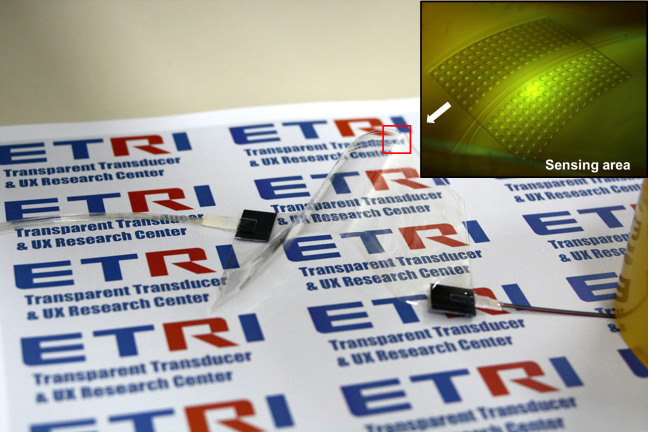ETRI invents sensors for flexible, transparent displays
By Shin Ji-hyePublished : July 16, 2014 - 21:11
Flexible and transparent displays have emerged as the next promising technology that could change the way consumers watch content on screens.
A local researcher, however, said they require new components such as circuits and sensors that also need to be flexible and transparent before the displays can be fully commercialized.
A team of South Korean researchers has recently developed flexible, transparent touch sensors which can better detect the intensity, direction and location of users’ fingers.
“The sensor, which is made of polymer, a type of plastic material, has no electrical material and can be fitted into rollable, bendable and foldable displays,” said Kyung Ki-uk, head of the state-run Electronics and Telecommunications Research Institute’s Transparent Transducer Center.
This waterproof flexible sensor is far superior to existing technology, which just senses contact with fingers or other objects.
A local researcher, however, said they require new components such as circuits and sensors that also need to be flexible and transparent before the displays can be fully commercialized.
A team of South Korean researchers has recently developed flexible, transparent touch sensors which can better detect the intensity, direction and location of users’ fingers.
“The sensor, which is made of polymer, a type of plastic material, has no electrical material and can be fitted into rollable, bendable and foldable displays,” said Kyung Ki-uk, head of the state-run Electronics and Telecommunications Research Institute’s Transparent Transducer Center.
This waterproof flexible sensor is far superior to existing technology, which just senses contact with fingers or other objects.

For instance, its sensing technology allows users to draw delicate pictures with lines in different thicknesses, and express a wide spectrum of low to high sounds when playing musical instrument apps on smartphones.
The way this works is that a certain amount of light is able to pass through the sensing panel depending on the contact pressure.
“Imagine water passing through a water hose. When you step on the hose, the amount of water flowing through is reduced. Like this, the sensor can tell how hard users press the panel by measuring the amount of light,” the researcher said.
The sensor, which is 0.05 mm thick and has a 90 percent transparency rate, can easily be attached to curved displays in the form of thin vinyl.
The technology can also be used for robots’ artificial skins as it can help them better recognize objects, according to ETRI.
The researcher is in discussions with several companies for commercialization.
“It will, however, take some time since the sensor is presently at the prototype stage,” Kyung said.
By Shin Ji-hye (shinjh@heraldcorp.com)








![[KH Explains] Hyundai's full hybrid edge to pay off amid slow transition to pure EVs](http://res.heraldm.com/phpwas/restmb_idxmake.php?idx=644&simg=/content/image/2024/04/18/20240418050645_0.jpg&u=20240419100350)







![[From the Scene] Monks, Buddhists hail return of remains of Buddhas](http://res.heraldm.com/phpwas/restmb_idxmake.php?idx=652&simg=/content/image/2024/04/19/20240419050617_0.jpg&u=20240419175937)

![[KH Explains] Hyundai's full hybrid edge to pay off amid slow transition to pure EVs](http://res.heraldm.com/phpwas/restmb_idxmake.php?idx=652&simg=/content/image/2024/04/18/20240418050645_0.jpg&u=20240419100350)

![[Today’s K-pop] Illit drops debut single remix](http://res.heraldm.com/phpwas/restmb_idxmake.php?idx=642&simg=/content/image/2024/04/19/20240419050612_0.jpg&u=)